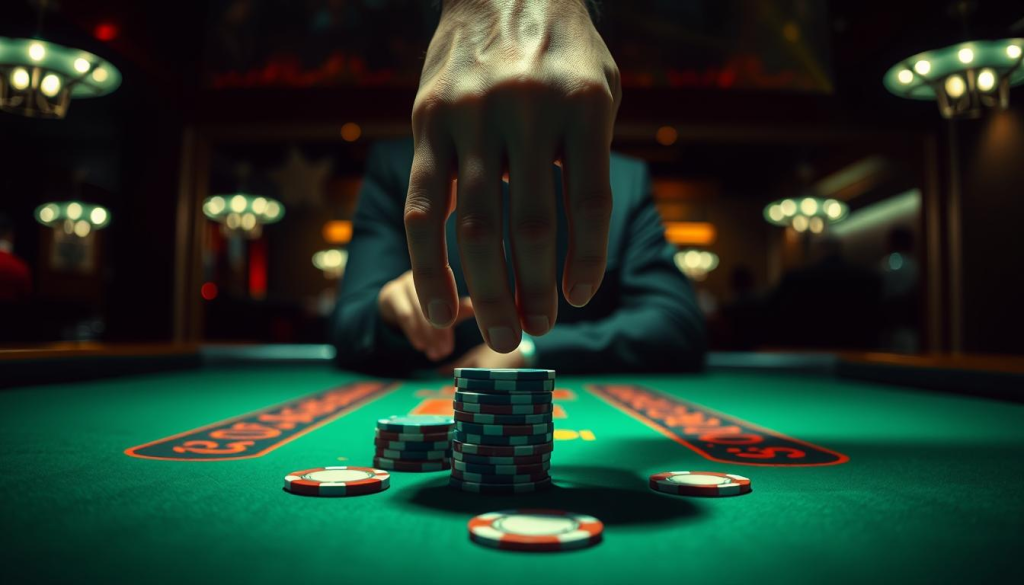The Martingale System is a betting strategy that has caught the eye of many gamblers. It’s based on probability theory. The idea is simple: after losing, you double your bet, hoping to win back what you lost.
This strategy has been around for decades. It’s popular because it seems to offer a way to beat the odds. In this article, we’ll dive into how the Martingale system works, its pros and cons, and its use in different games. With this knowledge, you can make better choices and possibly enjoy your gambling more.
Free AI Sports Prediction & Picks

Key Takeaways
- The Martingale System involves doubling your bet after each loss.
- This betting strategy is based on probability theory.
- Understanding the risks is essential for effective implementation.
- The system has been used in various betting games, including roulette and blackjack.
- It’s important to know the limits of this technique to avoid significant losses.
What is the Martingale System?
The martingale system is a betting strategy many gamblers use to try and win back losses. It’s based on doubling the bet after each loss. The idea is that a win will come soon, covering all previous losses and adding a profit.
This strategy comes from probability theory and interests both mathematicians and gamblers. It encourages a cautious betting approach. By using it, you aim to balance your bets based on statistical chances.
Using the martingale system, bets follow a pattern. This pattern shows how the bet doubles after each loss:
| Bet Number | Stake Amount | Outcome |
|---|---|---|
| 1 | $10 | Loss |
| 2 | $20 | Loss |
| 3 | $40 | Win |
In this example, the gambler loses twice but wins once. This strategy might seem appealing. But, it’s important to think about your bankroll and the betting game’s rules.
How the Martingale Betting Strategy Works
The martingale strategy is a well-known betting method. It’s based on a simple yet effective rule. After each loss, you double your bet to try and win back what you lost.
For example, if you start with a $1 bet and lose, your next bet is $2. If you lose again, you bet $4. This keeps going, doubling your bets with each loss.
The main goal is to win back all losses and make a profit equal to your first bet. With enough money and not too many losses, you could end up with a profit. But, it’s important to remember the risks. Losing too often can quickly use up your money, especially if you don’t have a lot to start with.

| Round | Bet Amount | Outcome | Profit/Loss |
|---|---|---|---|
| 1 | $1 | Loss | – $1 |
| 2 | $2 | Loss | – $3 |
| 3 | $4 | Loss | – $7 |
| 4 | $8 | Win | $1 (recovering all previous losses plus profit) |
The Probability Behind the Martingale System
The Martingale System is based on probability. It works on the idea that winning or losing is equally likely in most bets. For instance, flipping a coin gives you a 50% chance of heads or tails.
This suggests you might win once for every two bets. The system’s strategy is to double your bet after a loss. It believes a win will cover previous losses.
However, it’s important to remember that probability doesn’t guarantee a win after a certain number of bets. Losses can add up quickly. You might need to bet more than you started with.
The idea of equal probability can make gambling seem predictable. But, it can also lead to unexpected outcomes. You might lose all your money before winning.
Free AI Sports Prediction & Picks

The Evolution of the Martingale Strategy
The martingale system has seen big changes since the 18th century. It started in Europe’s gambling halls as a simple betting plan. Over time, it evolved into different forms.
One key change is the anti-Martingale system. Here, players bet more after winning, not losing. This can lead to bigger profits but also risks.
Today, the martingale system is used in finance too. Traders use it in forex and stock markets. It tries to make up for losses or increase gains. But, using it in finance is riskier because markets can be very unpredictable.
The history of gambling has influenced how we view betting strategies like the martingale system. It shows how a simple idea can be used in many ways. The martingale strategy’s evolution shows our ongoing search for good betting plans.

Advantages of Using the Martingale System
The Martingale system is known for its simple betting strategy. It’s easy to understand, making it great for beginners. By doubling your bet after each loss, you try to win back what you lost before. If done right, it can even lead to making money.
This strategy works best in games with almost even odds. For example, a coin toss has a 50% chance of winning. This makes players feel safer, knowing they’re less likely to lose a lot over time.
Using the Martingale system fits well with those who don’t like to lose. It gives you hope to win back what you lost. Each bet is a chance to not only get your money back but also to make more, keeping you positive.

Disadvantages and Risks Involved
The Martingale system is popular but comes with big downsides. It can lead to huge financial losses. If you keep losing, you have to double your bets, which can be very costly.
Casinos also have table limits. This means you can’t keep doubling your bets forever. If you hit the limit, you might not get your money back.
Your success with the martingale system is not guaranteed. The time between wins can be long, leading to big problems if you don’t watch your budget. Knowing the risks is key before using this strategy.
| Disadvantages | Risks |
|---|---|
| Escalating financial losses | Possibility of reaching table limits |
| High-pressure betting scenarios | Inability to recover from long losing streaks |
| False sense of security from short-term wins | Compounding losses leading to significant debt |
| Not suitable for all players | Risk of emotional decision-making during play |

How to Implement the Martingale Strategy Effectively
To start using the Martingale strategy, first set a budget that shows how much you can afford to lose. Begin with small bets to reduce your risk. The main rule is to double your bet after each loss to make back what you lost and earn a profit.
It’s also key to know when to stop betting. Having a clear plan for when to quit can prevent big losses during a losing streak. By setting limits on your bets and how long you’ll play, you can improve your chances of winning. This approach helps you enjoy the game more and possibly earn more.

Martingale System in Different Betting Games
The martingale system is used in many betting games like blackjack, roulette, and baccarat. In roulette, betting on red or black is common because of the almost even odds. This strategy is simple: double your bet after losing until you win.
Every game has its own rules and dynamics. Knowing these is key to using the martingale system well. For example, in blackjack, you need to think about card counting and table limits too.
The martingale system isn’t just for betting games. It’s also used in forex trading to manage risk. But, there are risks in these areas that are different from betting. Knowing your environment well is important to do well and avoid risks.

Comparing Martingale with Other Betting Strategies
The Martingale system stands out when compared to other betting strategies. It’s known for its bold approach, where bets double after each loss. This can lead to big wins if luck is on your side. However, it requires a big bankroll, which might not fit everyone’s needs.
Other strategies, like flat betting and the Fibonacci system, offer different advantages. Flat betting keeps your bets the same, helping manage your bankroll and reducing stress. The Fibonacci system uses a math sequence for bets after losses. It’s great for those who like a structured method with some risk.
Choosing between Martingale and other strategies depends on your personal style and goals. Knowing how each fits your approach can help you make the best choice.
Free AI Sports Prediction & Picks

Real-Life Examples of Martingale in Action
The Martingale system has caught the interest of many, leading to countless stories from casinos and online betting sites. Players who doubled their bets after losing have seen their luck change. This method seems to offer a quick way to make back lost money.
Many gamblers at roulette tables have shared their wins after using the martingale strategy. They managed to turn their losses into big wins.
However, there are also cautionary tales. Some players lost a lot of money by sticking to the martingale system for too long. These stories remind us that while martingale can lead to quick wins, it also carries risks.
Understanding both sides of these stories is key. It helps you develop a better strategy and appreciate the importance of managing your bankroll. Knowing when to stop is just as important as knowing when to start using the martingale method.

Conclusion
The Martingale system is a fascinating betting strategy that many find appealing. It has the potential to help you recover losses and even make profits. However, it’s important to understand the risks involved.
When considering the Martingale system, remember that no strategy can guarantee success. Your judgment and how you use the system are key. By being cautious and balanced, you can make the most of your betting experience.
It’s important to approach the Martingale system with thoughtfulness. Recognize both its possibilities and limitations. Responsible gambling should always be a priority. Enjoy the thrill of betting while being mindful of the risks!
Free AI Sports Prediction & Picks
FAQ
What is the Martingale System?
The Martingale System is a betting strategy. It involves doubling your bet after each loss. The goal is to win back all lost money plus a profit equal to your first bet. It’s based on the idea that you will eventually win because winning and losing are equally likely.
How does the Martingale Strategy work?
The Martingale Strategy works by doubling your bet after each loss. For example, if you start with a $1 bet and lose, you bet $2 next. If you lose again, you bet $4. The aim is to win back all lost bets and make a profit equal to your first bet.
What are the risks associated with using the Martingale System?
Using the Martingale System can lead to big financial losses. If you keep losing, your bets can grow very high. This can put a lot of pressure on your finances. Also, casinos often have limits on how much you can bet, which can stop you from doubling your bets forever.
Can the Martingale System guarantee success in betting?
No, the Martingale System doesn’t guarantee success. It can help you recover losses and make profits quickly. But, it also carries risks like long losing streaks that can cause big financial losses. It’s important to be careful when using this system.
Is the Martingale Strategy effective in all betting games?
The Martingale System can be used in games like blackjack, roulette, and baccarat. But, its success can vary. It’s key to understand the rules of each game and how house rules might affect your chances.
How can I implement the Martingale Strategy effectively?
To use the Martingale Strategy well, start with a clear budget and stick to it. Begin with small bets to reduce risk. Double your bet after each loss. It’s also important to have a plan for when to stop betting, especially after losing a lot.
How does the Martingale System differ from other betting strategies?
The Martingale System is unique because it requires you to increase your bets after losses. It’s not for everyone, especially those who can’t afford to lose a lot. Other strategies, like flat betting or the Fibonacci system, are more cautious and might be safer for some.
Who created the Martingale System?
The Martingale System was first thought of by French mathematician Paul Pierre Lévy. He was a big name in probability theory. Since then, the system has become popular and has evolved, including the anti-Martingale strategy.
Can I use the Martingale System for forex trading?
Yes, you can use the Martingale System in forex trading and stock trading. Traders might try to recover losses or grow their investments. But, using this strategy in financial markets comes with its own set of risks that are different from betting.

